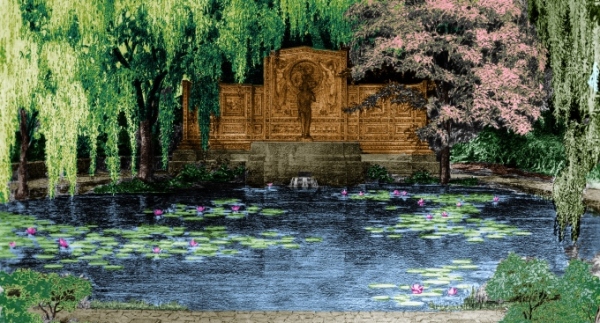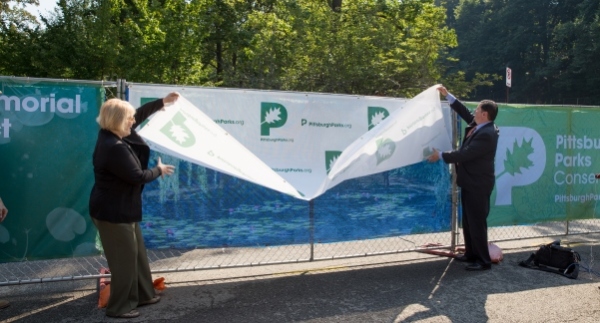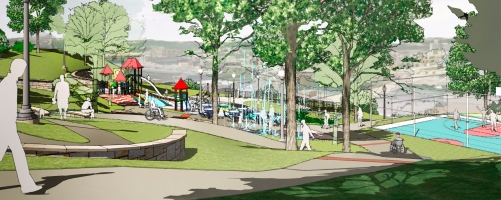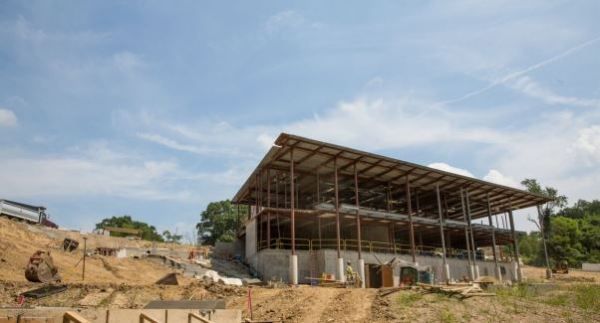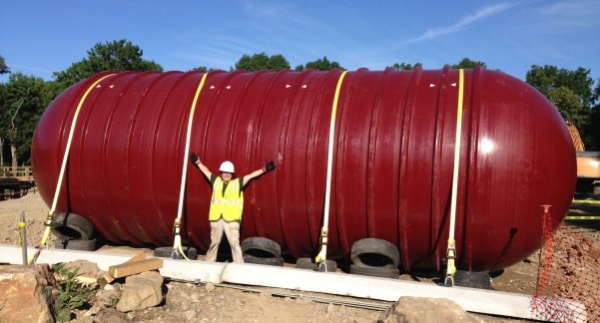Let’s take a tour.
When I sat nervously in my now boss’ office to interview for my job a little over a year ago, I told him with heartfelt sincerity that I wanted to work for the Pittsburgh Parks Conservancy because the organization had in one way or another touched the lives of everyone in this city. I touted my connections to various Conservancy projects – I lived in Highland Park as a teenager when the reflecting pool and fountain was filled in with dirt and drab shrubbery. I saw the Schenley Park Café and Visitor Center with its patina of cracked paint and vending machines standing where flower beds now lay. As a Pitt student I watched an Oakland parking lot’s metamorphosis into Schenley Plaza. Last year I was married in the newly restored Walled Garden in Mellon Park.
Many Pittsburghers are familiar with the Conservancy’s numerous projects in our parks in partnership with the City or are connected to our volunteer and educational programs. What is remarkable to me in my three hundred and however-many-days with this organization is how the Conservancy’s reach continues to grow. Every once in a while, our office staff has the opportunity to power down our computers and go out into the parks to see the progress first hand. With the expertise of our Parks Curator Susan Rademacher, Parks Maintenance and Management Director Phil Gruzska, and Director of Education Marijke Hecht in tow, we get to discover new park spaces and connect to our current projects and the people they impact.
Since you and I have become such good friends, I thought it might be nice for you to come along as well to see what we’re working on…
McKinley Park

The historic stone wall and stairs at Delmont Ave. will be restored
I must admit that I’d never been to McKinley Park before this visit, but I could see immediately why it is so beloved by the Beltzhoover, Bon Air, and Knoxville neighborhoods that frame this lush green space. Once part of Melchoir Beltzhoover’s farm, the future park became a popular picnic spot with early German settlers. It was first known as “Butchers Grove” following an oxen roast held there by butchers and slaughterhouse employees on July 4, 1875. In that same year, the developers Benjamin McLain and Thomas Maple purchased the Beltzhoover Farm and began laying out neighborhood streets and housing lots. Soon, the land reserved for green space was dubbed Maple Park for Thomas Maple. In 1898, the historically German borough of Beltzhoover was annexed by the City of Pittsburgh, which also bought Maple Park from McLain and Maple. The park was given its current name following the assassination of President McKinley in 1901.

Rendering of the proposed restoration of the Delmont Ave. entrance, by Carlos Peterson
For the past 16 years, the Parks Conservancy has focused its work in Pittsburgh’s four historic Regional Parks – Frick, Highland, Riverview, and Schenley while also working in other parks as our resources allow. Our current improvement plan for McKinley is a first step into this very special neighborhood park. The project will be focused at the park’s Delmont Avenue entrance serving the community center, playground, and basketball court. There we will repair the historic stone entry wall and steps. The project will also feature a first in Pittsburgh when we repave the parking lot using special porous asphalt which will absorb storm water, eliminating the need for piping and halting soil erosion. Strategically placed rain gardens will assist, as well as provide beautiful landscaping for the entry. Work in McKinley is currently slated to begin in September 2012.
Mellon Square
On June 13, 2011, we broke ground on one of the Conservancy’s most ambitious capital projects to date – the total restoration of downtown Pittsburgh’s Mellon Square. In 1955 this 1.37-acre modern garden rooftop plaza was the first of its kind to be built in conjunction with a new parking garage. The Square was designed by the esteemed landscape architecture firm of Simonds and Simonds in collaboration with the architects Mitchell and Ritchey. Today the Square is a favorite gathering place for downtown residents and employees, but its shine has dulled significantly over decades of use.

Terrace construction
We are in the process of restoring all aspects of the Square including the custom triangular graphic paving known as Rustic Venetian Terazzo, the planters and landscaping, both the Central Fountain and the Cascade Fountain, and lighting. Additionally, we are converting a former planter into a new Terrace above the shops along Smithfield Street creating 15% more useable space in the Square. This idea was included in one of the early design concepts from 1950 and we saw it as an excellent solution to a problem space. The new Terrace will also provide views of the dramatic Cascade Fountain not previously possible.

The Central Fountain demolished
I hadn’t been inside the Square since our groundbreaking ceremony over a year ago and I was taken aback by the size of the vacant space that had once been occupied by the Central Fountain. This beautiful feature of the Square is being completely rebuilt, complete with its lightshow. The restoration of the fountain’s huge bronze bowls is safely in the hands of their creators at Matthews International. The complexity of the construction is also remarkable, with access to some of the Square’s plumbing as far as three levels deep into the underground parking garage.

Rendering of the completed Mellon Square by Robert Bowden
Final completion dates are directly tied to the moving target that construction often becomes. Currently the Terrace is slated to be complete in mid-August and the Cascade Fountain in mid-September, with total completion anticipated in the spring of 2013. We appreciate the patience and support of Mellon Square’s dedicated users as we complete this important project to benefit downtown Pittsburgh. You can watch our progress via flickr.
Cliffside Park

Cliffside Park’s current play space
The aptly named Cliffside Park descends from Cassatt Street in Pittsburgh’s Hill District neighborhood to overlook the Allegheny River. The space beams with potential for gorgeous views and a reprieve from the hustle and bustle of the city above. A favorite community space for birthday parties, quilting clubs, and family gatherings, the park has fallen into an unfortunate state of disrepair. Limited accessibility through a single steep park entrance, overgrown plants, and deteriorated equipment have all marginalized a space that should be a part of the Hill District’s outstanding regeneration.

Rendering of proposed restoration of Cliffside Park, by Carlos Peterson
The Parks Conservancy became involved at Cliffside as a result of our partnership with the Hill House Association in producing the Greenprint plan for the Hill. Current design plans for Cliffside include making the entire park universally accessible, managing storm water through a runnel and rain gardens to prevent further erosion of the hillside, redesigning the play equipment to take advantage of the landscape’s natural slope, constructing a half-size basketball court, landscaping, and establishing an Overlook by removing the overgrowth of invasive plant species and pruning trees. With additional funding we also hope to include a pop-up fountain similar to the ones found in PPG Place and the South Side Works, but on a smaller scale.
Plans are currently being finalized with enthusiastic community support. We anticipate that we will be able to break ground on this exciting project early in 2013.
The Environmental Center at Frick Park

Located off Beechwood Blvd in Squirrel Hill
Frick Park has long been Pittsburgh’s premier natural classroom. In the 1930s, Helen Clay Frick funded the first Frick Nature Center. Its educational program earned national recognition as one of the most outstanding conducted by a park system in the country. The program moved from its original site in an old home along Beechwood Boulevard into a new building near the historic gatehouses in 1979.
For decades, the program continued to thrive in its new home. Unfortunately, that building was burned by arsonists in 2002. For the past 10 years, a dedicated team of Citiparks educators have continued work out of the gatehouses and trailers to provide programming that puts kids in touch with nature. We believe the people of Pittsburgh deserve better.

The current Frick Park Environmental Center workspace
The new Environmental Center at Frick Park will include both indoor and outdoor learning spaces, expanded staff, programming, and improved public access. The construction of the main building will take on the remarkable Living Building Challenge which requires (among many other things) that the building generate all energy and capture all rain water right on site. We also plan to restore the two historic gatehouses and the landscape designed by Innocenti and Webel in 1927, including the circular fountain which is currently being used as a planter. Alongside the main building, amphitheater seating will be built into the natural slope of the hill to provide space for relaxing, classes, and performances. The parking area will be reconfigured with trellises which will shade cars while overhead solar panels simultaneously capture the energy needed to operate the Center.

Rendering of the proposed Environmental Center with amphitheater and wetlands, by Bohlin Cywinski Jackson
Most importantly, the new Environmental Center will continue the long tradition of outdoor education in Frick Park. The current program serves approximately 3,000 visitors annually. Our hope is that we can increase this number to 20,000 by the fifth year of operation in the new Center. We will all benefit from this greater impact because these young people will establish meaningful connections with nature which encourages them to become citizens who conduct their lives with thoughtful consideration for their impact on the natural world.
We are currently in the final stages of design which reflects several years of community input through workshops and meetings. We hope to break ground on this vital project sometime in 2013, once final funding is secured and construction plans are completed. We are also working on an operating agreement with the City. You can see more images of the Environmental Center design by the firm Bohlin Cywinski Jackson here.
Kathleen Gaines is a Development Associate at the Pittsburgh Parks Conservancy.
Please visit our website to make a donation to any of these important park projects. Be sure to designate your gift to the project you choose, or become a member to provide vital operating funds. To learn more about our work in Pittsburgh’s Parks check out our 15th Anniversary Magazine.





